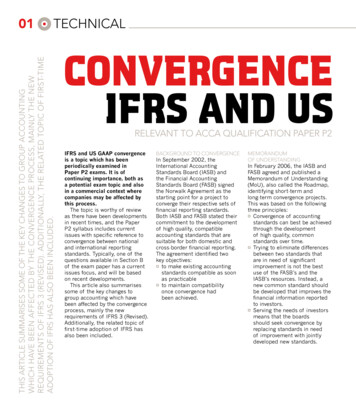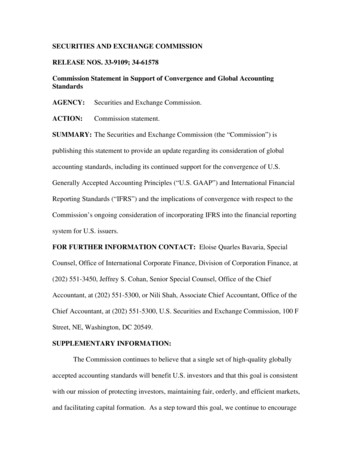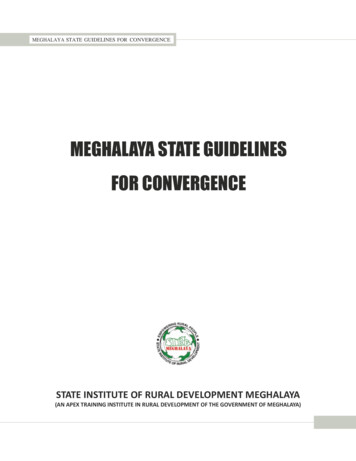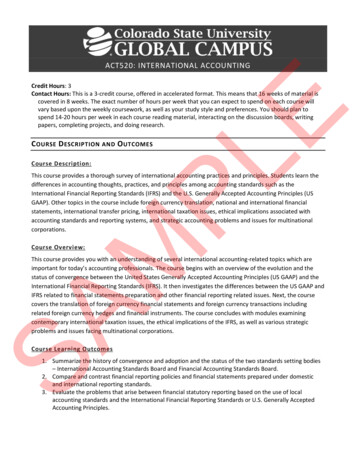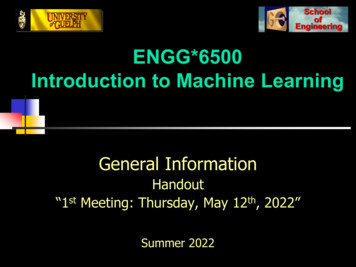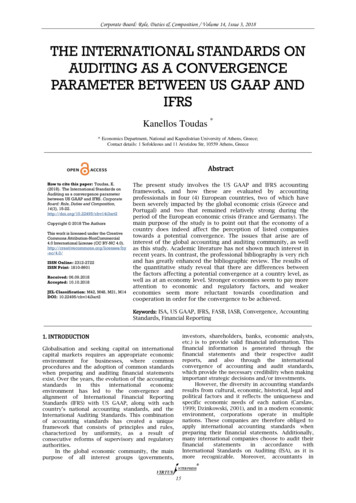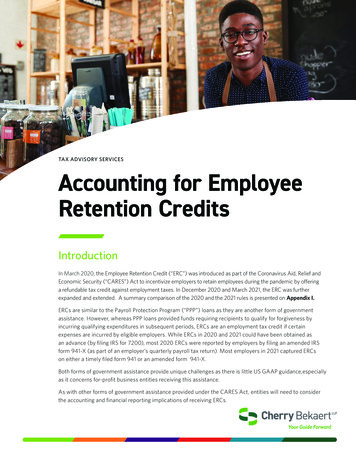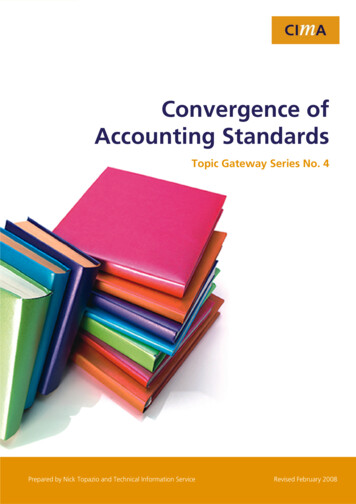
Transcription
Topic Gateway seriesConvergence of Accounting StandardsConvergence ofAccounting StandardsTopic Gateway Series No. 41Prepared by Nick Topazio and Technical Information ServiceRevised February 2008
Topic Gateway seriesConvergence of Accounting StandardsAbout Topic GatewaysTopic Gateways are intended as a refresher or introduction to topics of interestto CIMA members. They include a basic definition, a brief overview and a fullerexplanation of practical application. Finally they signpost some further resourcesfor detailed understanding and research.Topic Gateways are available electronically to CIMA members only in the CPDCentre on the CIMA website, along with a number of electronic resources.About the Technical Information ServiceCIMA supports its members and students with its Technical Information Service(TIS) for their work and CPD needs.Our information specialists and accounting specialists work closely together toidentify or create authoritative resources to help members resolve their workrelated information needs. Additionally, our accounting specialists can help CIMAmembers and students with the interpretation of guidance on financial reporting,financial management and performance management, as defined in the CIMAOfficial Terminology 2005 edition.CIMA members and students should sign into My CIMA to access these servicesand resources.The Chartered Instituteof Management Accountants26 Chapter StreetLondon SW1P 4NPUnited KingdomT. 44 (0)20 8849 2259F. 44 (0)20 8849 2468E. tis@cimaglobal.comwww.cimaglobal.com2
Topic Gateway seriesConvergence of Accounting StandardsConvergence of Accounting StandardsDefinition and conceptIn a financial reporting context, convergence is the process of harmonisingaccounting standards issued by different regulatory bodies. One example mightbe the convergence of International Accounting Standards (IAS) and USStandards.The objective is to produce a common set of high quality accounting standards toenhance the consistency, comparability and efficiency of financial statements.ContextIn the current syllabus, CIMA students will learn and may be examined on thistopic in Paper P7 Financial Accounting and Tax Principles. Study Systems for thesepapers are available from CIMA Publishing.OverviewThere are two aspects to the current convergence debate. International Convergence – the process within which the InternationalAccounting Standards Board (IASB) and National Standard-Setters (NSS) areconverging their respective financial reporting standards into one global setof accounting regulations. National GAAP Convergence – the adoption of International Standards asnational GAAP. For example, the Accounting Standards Board (ASB) in theUK is working to converge its own financial reporting standards with thoseof the IASB.The two aspects are clearly intertwined: the IASB works with the NSS in onecountry to converge IAS and local Generally Accepted Accounting Practice(GAAP), which has implications for the convergence of local GAAP in anothercountry with IAS.3
Topic Gateway seriesConvergence of Accounting StandardsConvergence in practiceAn international perspectiveA single global comprehensive set of accounting standards is a conceptual ideal. It would help to ensure the comparability of financial statements It would allow companies to enjoy a lower cost of capital as a result of theirfinancial statements being more readily understood. A single set ofaccounting standards would ensure lower barriers to the free movement ofaccountants in business across jurisdictions.Significant events on the road to international convergence have been: March 2002 - EU Decision to adopt IAS for the consolidated accounts of itslisted companies September 2002 - the Norwalk Agreement in which IASB and FASB eachacknowledged their commitment to develop high quality, compatibleaccounting standards for both domestic and cross-border financial reporting October 2004 - the IASB and the Accounting Standards Board of Japanagreed to discuss a joint project to minimise differences between IFRS andJapanese accounting standards, with a final goal of convergence of theirstandards January 2006 - Canada’s Accounting Standards Board approved a plan forconvergence with IFRS February 2006 - the Chinese Ministry of Finance announced the adoption ofa new Chinese accounting standards system to bring about substantialconvergence with IFRS November 2007 – the US SEC announce that convergence has progressedsufficiently for them to remove the requirement for overseas companies tofile a reconciliation to US GAAP with their IFRS financial statements February 2008 – the US SEC announced that their 2008 agenda wouldinclude a continuation of the progress being made in the US towardsacceptance of IFRS for domestic filers.There are now over 100 countries worldwide that either require or allow the useof IAS for financial statements. This figure is expected to grow to 150 countriesby 2011.4
Topic Gateway seriesConvergence of Accounting StandardsKey to this continued movement towards the use of international standards is theacceptance of IAS in the US. Although international standards and US GAAP arenot identical, there is a general acceptance by the SEC that convergence hasprogressed sufficiently well to date and there is a programme in place to bringthem even closer together. The IASB agenda still contains a number ofconvergence projects, including: joint ventures impairment income tax research and development consolidation financial statement presentation fair value measurement revenue recognition pensions.The European perspectiveThe EU is one of the major users of IAS in terms of market capitalisation.Approximately 8,000 European companies report their consolidated accountsusing IAS. As such, the European Commission (EC) is particularly interested in theconsequences of pace of convergence between US GAAP and IAS. The USaccounting system is generally recognised to be more rules-based than itsinternational counterpart, which is known to be principles-based.Supporters of a principles-based regime argue that a rules-based system is easierto circumvent. This issue has particularly concerned European regulators andresolution of this tension is crucial to continued international convergence.The removal of the reconciliation requirement by the SEC referred to above is ofparticular interest to Europe. There are approximately 400 EU companies whichare listed in both the EU and on a US stock market. The accounts of thesecompanies are prepared using IAS and they need to file a reconciliation of theirresults to US GAAP. It is estimated that reconciliation work (including auditassurance) costs the largest companies up to ten million Euros.5
Topic Gateway seriesConvergence of Accounting StandardsOnce International Financial Reporting Standards have been issued by the IASB,they need to be endorsed by the EC before they can be used in Europe. At thepresent time, there are certain sections of IAS 39 Financial Instruments that havenot been approved for use by European companies. This so-called ‘carve-out’ hasthe potential to delay the benefits of convergence for European companies filingtheir financial statements in the US.The original relaxation of the requirement to include a US GAAP reconciliationwas for those companies preparing their accounts using IFRS ‘as published by theIASB’, not ‘as endorsed by the EC’. As a result of representations by the EC, theSEC agreed to a two-year exemption for European companies, but after thateither the ‘carve-out’ must be removed or a US GAAP reconciliation must beincluded.National GAAP convergence in practice: a UK perspectiveAlong with its European partners, the UK requires listed groups to prepare theirconsolidated accounts using IAS. Unlisted groups, subsidiaries of listed groupsand other companies are not required to use IAS but may do so. Those that donot use IAS need to apply the principles of UK GAAP.Consistency between UK standards and IAS is important: for the credibility and understanding of financial reporting for companies choosing to continue preparing their financial statementsunder UK standards, but who also wish to ensure consistency with IAS intheir financial statements in facilitating the movement of business accountants between organisationsusing either UK GAAP or IAS.In March 2004, the ASB issued a discussion paper Strategy for Convergence ofUK GAAP with IAS. Here the ASB proposals were to adopt UK standards basedupon the principles of IAS. There would be a phased approach to convergencerather than the ‘big bang’ approach as adopted by the EU in respect to theintroduction of IAS. CIMA supported this strategy, along with many others.The next step in the ASB’s due process was to issue an exposure draft in March2005. The draft ‘Accounting Standard-Setting in a Changing Environment: theRole of the ASB’ reiterated the ASB’s view to converge with IAS, using a phasedapproach. The aim would be to bring UK standards fully in line within a period ofthree to four years.6
Topic Gateway seriesConvergence of Accounting StandardsThe impact of the first joint IASB/ FASB consultationDuring the consultation period, the IASB issued an exposure draft on businesscombinations. This document was a result of a joint project with the FASB.Commentators felt that it contained some quite fundamental changes to theprinciples of IAS and also highlighted the complexity of trying to converge arules-based system with a principles-based system. Most respondents to theIASB’s exposure draft felt that the correct balance had not been struck andrejected the joint IASB/ FASB proposals.Many respondents to the ASB exposure draft felt the time was right for the ASBto reconsider its phased approach to convergence. They favoured a pause inconvergence efforts before a ‘big bang’ implementation. The ASB listened to theviews of its constituents and now proposes to issue new IAS-based UKaccounting standards that will not be mandatory before a specific date. This wasoriginally expected to be financial years beginning on or after 1 January 2009 butis now expected to be later.The ASB website lists the following convergence projects as current workload: business combinations inventories: construction and service contracts (FRED 28) property, plant and equipment: borrowing costs (FRED 29) disposal of non-current assets and presentation of discontinued operations.The IASB are developing an accounting standard for small and medium sizedcompanies (IFRS for SMEs). This is causing an interesting debate within the UK.At present, listed UK companies must report using IFRS, while unlisted or privatecompanies are subject to a two-tier GAAP system. The UK’s financial reportingstandard for small entities (FRSSE) is available for SMEs to use, whereas full UKGAAP applies elsewhere.There are two schools of thought in the UK at the moment regarding the IASB’sIFRS for SMEs. The first believes that the SME standard, when published, wouldbe applicable for all companies in the UK other than those that apply full IFRS.The second school would retain the FRSSE for our smallest companies.The ASB held a public round-table discussion in January 2006 to address thissubject. However, no consensus was reached. To date, the ASB has produced noguidance as to who would have to apply the proposed SME standard.CIMA believes that the SME standard should not be applicable to our smallest7
Topic Gateway seriesConvergence of Accounting Standardscompanies, which should continue to use the FRSSE. The requirement to use fullIFRS should be extended to include larger unlisted public interest entities. TheSME standard would apply for those companies falling between these twocategories.After a period of ‘watching and waiting’, it is anticipated that the ASB will startto move the convergence debate forward again in the UK in 2008.Further informationArticlesFull text available from Business Source Corporate through My CIMA.www.cimaglobal.com/mycima[Accessed 5 March 2008]Larson, R.K. and Street, D. L. The road map to global accounting convergence.CPA Journal, October 2006, Volume 76, Issue 10, pp 36-43Ross, L. Accounting standards: where to go for advice. CIMA Insight. June 2005.Available from: www.cimaglobal.com/insight[Accessed 5 March 2008]Ross, L. International standards: time for some last minute wrapping up. CIMAInsight, December 2003. Available from: www.cimaglobal.com/insight[Accessed 5 March 2008]Schipper, K. The introduction of International Accounting Standards in Europe:implications for international convergence. European Accounting Review, May2005, Volume 14, Issue 1, pp 101-126Topazio, N. 2008 convergence target raises European fears. CIMA Insight, April2006. Available from: www.cimaglobal.com/insight[Accessed 5 March 2008]Topazio, N. Meeting stirs tensions over timing of convergence. CIMA Insight,December 2005. Available from: www.cimaglobal.com/insight[Accessed 5 March 2008]Tweedie, D. and Seidenstein, T. R. Setting a global standard: the case foraccounting convergence. Northwestern Journal of International Law andBusiness, Spring 2005, Volume 25, Issue 3, pp 589-6088
Topic Gateway seriesConvergence of Accounting StandardsTyrall, D. Continental drift. CIMA Financial Management, June 2005, pp 10-14.Available from: www.cimaglobal.com/financialmanagement[Accessed 5 March 2008]Whittington, G. International accounting standards: where next? CIMA Insight,March 2005. Available from: www.cimaglobal.com/insight[Accessed 5 March 2008]The coming convergence: global accounting standards. California CPA, July 2007,Volume 76, Issue 1, pp 11-14IFAC’s international public sector accounting standards board advances globalconvergence. Accountancy Ireland, June 2008, Volume 40, Issue 3, p. 52ArticlesAbstract available from Business Source Corporate through My CIMA.www.cimaglobal.com/mycima[Accessed 5 March 2008]Fontes, A., Rodrigues, L. L. and Craig, R. Measuring convergence of NationalAccounting Standards with International Financial Reporting Standards.Accounting Forum (Elsevier), December 2005, Volume 29, Issue 4, pp 415-436FASB and IASB reaffirm commitment on accounting convergence. AFP Exchange,April 2006, Volume 26, Issue 3, pp 15-16BooksKirk, R. (2005). International financial reporting standards in depth. London:CIMA PublishingKirk, R. (2004). UK accounting standards. London: CIMA PublishingCIMA MastercoursesCompany accounting in the USA. To book via CIMA Mastercourseswww.cimamastercourses.com please go to Find and key in the course codeCUSA.International financial reporting standards: core standards and update. To bookvia CIMA Mastercourses www.cimamastercourses.com please go to Find andkey in the course code INAS.Financial reporting in France and Germany: European financial reporting practicesin detail. To book via CIMA Mastercourses www.cimamastercourses.complease go to Find and key in the course code FRFR.9
Topic Gateway seriesConvergence of Accounting StandardsThe accounting standards masterclass. To book via CIMA Mastercourseswww.cimamastercourses.com please go to Find and key in the course codeASMC.WebsitesThe Accounting Standards BoardAvailable from: www.frc.org.uk/asb[Accessed 5 March 2008]The International Accounting Standards BoardAvailable from: www.iasb.org/Home.htm[Accessed 5 March 2008]The Financial Accounting Standards BoardAvailable from: www.fasb.org[Accessed 5 March 2008]The Federation of European AccountantsAvailable from: www.fee.be[Accessed 5 March 2008]The European Financial Reporting Advisory Group (EFRAG)Available from: www.efrag.org/homepage.asp[Accessed 5 March 2008]EU Financial Reporting NewsAvailable from: http://digbig.com/4xxag[Accessed 5 March 2008]Deloitte have a website dedicated to developments in International AccountingStandards and Convergence projects of national standards-setting bodies.Available from: www.iasplus.com/index.htm[Accessed 5 March 2008]Further informationStay up-to-date with developments in the field of financial reporting by readingthe Financial Reporting News section of CIMA’s electronic newsletter Insightpublished monthly.Nicolaisen, D. T. Statement by SEC staff: a securities regulator looks atconvergence. Northwestern University Journal of International Law and Business,April 2005.Available from: http://digbig.com/4xxah[Accessed 5 March 2008]10
Topic Gateway seriesConvergence of Accounting StandardsFinancial Reporting: Convergence, Equivalence and Mutual Recognition. FEEPosition Paper, FEE, March 2006. Available from: www.fee.be[Accessed 5 March 2008]US FASB and IASB reaffirm commitment to enhance consistency, comparabilityand efficiency in global capital markets. IASB news release, 27 February 2006.Available from: www.cimaglobal.com/mycima[Accessed 5 March 2008]Community of practiceRegistered community membersIf you have received confirmation from CIMA that you are a registered memberof the Financial Reporting Community of Practice you can access the onlinediscussion forum through My CIMA.Available from: www.cimaglobal.com/mycima[Accessed 5 March 2008]PurposeThe Financial Reporting Community of Practice has been set up for memberswho are directly affected by financial reporting issues and developments.Community discussions will be focused on, but not limited to, publicconsultations on financial reporting for which CIMA is developing a response. Inaddition, news items and other sources of information that community membersmay not aware of will be highlighted.Further information on purpose and discussion topics.Benefits of participatingMembers currently involved in financial reporting, will find that activeparticipation in community discussions is a convenient, cost-effective way ofhelping to meet their CPD needs. This will be especially useful for experiencedpractitioners who may find it difficult to identify challenging CPD opportunities inthis area.Community members will be able to readily access each other’s expertise, sharegood practice, and benefit from networking and benchmarking opportunities.An overview of the benefits of participating.Opportunity to joinA number of members have been invited to join the financial reporting11
Topic Gateway seriesConvergence of Accounting Standardscommunity of practice. They were selected because their employment detailsindicate that they will be able to provide useful practical insight and experience,and are likely to benefit the most from participation.If your current professional role and expertise in this area would enable you tocontribute to forum discussions, and you would like to join this community pleaseemail tis@cimaglobal.com or phone Bill Haskins on 44 (0)20 8849 2385.Further informationTopazio, N. Financial reporting. Financial Management, February 2007,p. 30. Available from: www.cimaglobal.com/financialmanagement[Accessed 5 March 2008]Topazio, N. IFRS: is the worst still to come? CIMA Insight, February2007. Available from: www.cimaglobal.com/insight[Accessed 5 March 2008]Communities of Practice topic gateway through My CIMAwww.cimaglobal.com/mycima[Accessed 5 March 2008]Copyright CIMA 2006First published in 2006 by:The Chartered Institute ofManagement Accountants26 Chapter StreetLondon SW1P 4NPUnited KingdomPrinted in Great BritainNo responsibility for loss occasioned to any person acting or refraining fromaction as a result of any material in this publication can be accepted by theauthors or the publishers.All rights reserved. No part of this publication may be reproduced, storedin a retrieval system, or transmitted, in any form or by any means methodor device, electronic (whether now or hereafter known or developed),mechanical, photocopying, recorded or otherwise, without the priorpermission of the publishers.12Permission requests should be submitted to CIMA at tis@cimaglobal.com
IASB's exposure draft felt that the correct balance had not been struck and rejected the joint IASB/ FASB proposals. Many respondents to the ASB exposure draft felt the time was right for the ASB to reconsider its phased approach to convergence. They favoured a pause in convergence efforts before a 'big bang' implementation.
